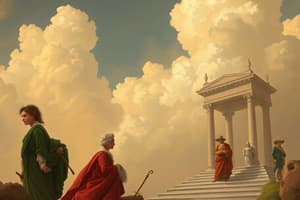Podcast
Questions and Answers
What important events occurred in the 1700s?
What important events occurred in the 1700s?
- World War I
- Enlightenment (correct)
- American Civil War
- Industrial Revolution
What are the dates for Rococo?
What are the dates for Rococo?
1715-1785
What are the dates for Neoclassicism?
What are the dates for Neoclassicism?
1760-1820
Which of the following artists are considered important in Neoclassicism?
Which of the following artists are considered important in Neoclassicism?
Describe the Neoclassicism art movement.
Describe the Neoclassicism art movement.
Who is Winckelmann?
Who is Winckelmann?
How did Classical Greek culture represent the zeitgeist before the revolution?
How did Classical Greek culture represent the zeitgeist before the revolution?
What is notable about Jaques-Louis David?
What is notable about Jaques-Louis David?
What is the significance of David's painting 'Oath of Horatii'?
What is the significance of David's painting 'Oath of Horatii'?
What themes are present in David's painting 'The Death of Marat'?
What themes are present in David's painting 'The Death of Marat'?
Who was Marat?
Who was Marat?
About Antonio Canova, what does he represent?
About Antonio Canova, what does he represent?
What is 'Psyche Revived by Cupid's Kiss' related to?
What is 'Psyche Revived by Cupid's Kiss' related to?
Match the following transitions in art movements with their characteristics:
Match the following transitions in art movements with their characteristics:
What was Ingres' view on female nudity in art?
What was Ingres' view on female nudity in art?
Flashcards are hidden until you start studying
Study Notes
18th Century Neoclassicism Overview
- The 18th century marked significant cultural shifts, including the Enlightenment and the French Revolution in 1789, establishing Paris as the art capital and with Napoleon emerging as a key figure.
Rococo and Neoclassicism Dates
- Rococo: 1715-1785, characterized by ornate designs and lightness.
- Neoclassicism: 1760-1820, emphasizing classical inspiration and moral subjects.
Notable Artists
- Key figures in Neoclassicism include Jacques-Louis David, Antonio Canova, and Thomas Jefferson.
Characteristics of Neoclassicism
- Focused on classical subjects to convey moral lessons.
- Emerged as a reaction to the frivolity of Rococo.
- Influenced by Enlightenment ideals of reason, knowledge, and a revival of Greco-Roman culture.
- Emphasized geometric harmony, rationality, and political relevance amid social upheaval.
Johann Joachim Winckelmann
- A scholar who idealized Greek art, advocating for its integration into modern artistry as a standard of perfection.
Influence of Classical Greek Culture
- Represented notions of liberty, morality, and sacrifice, resonating with pre-revolutionary sentiments.
Jacques-Louis David
- Noted for ethical beauty and neoclassical ideologies.
- Sought to inspire patriotism and heroic themes in art.
- Utilized ancient and Renaissance models for inspiration.
David's Key Works
-
Oath of Horatii (1784):
- Depicted figures resembling classical statues; acted as revolutionary propaganda despite royal patronage.
- The work showcased themes of honor and self-sacrifice against a symmetrical backdrop.
-
The Death of Marat (1793):
- Employed orthogonal construction to convey a sense of timelessness.
- Used dark backgrounds to symbolize death while immortalizing Marat through his heroic portrayal.
Jean-Paul Marat
- A radical journalist and politician during the French Revolution.
- Known for his aggressive tactics against the elite and reforms for the impoverished.
- Assassinated by Charlotte Corday, which David transformed into a historical propaganda piece.
Antonio Canova
- Represented ideals of aesthetic beauty, striving for perfection unattainable in nature through classical art knowledge.
- A prominent figure in neoclassical sculpture, known for his early works in Venice and later influences from Bernini.
Canova's Notable Work
- Psyche Revived by Cupid’s Kiss (1787):
- Represents the essence of ideal beauty through classical themes; specific details to be referenced from additional material.
Transition Between Artistic Movements
- The evolution from Neoclassicism to Romanticism and then to Realism illustrates a shift from rational thought to emotional expression and finally to observance of reality.
Ingres and Artistic Innovation
- Jean-Auguste-Dominique Ingres blended Neoclassicism with Romanticism, reinterpreting female nudity as a symbol of ideal beauty.
- His work La Grande Odalisque (1814) invoked criticism due to elongated proportions and lack of anatomical adherence, showcasing a departure from David’s ideologically driven nudes.
Studying That Suits You
Use AI to generate personalized quizzes and flashcards to suit your learning preferences.




